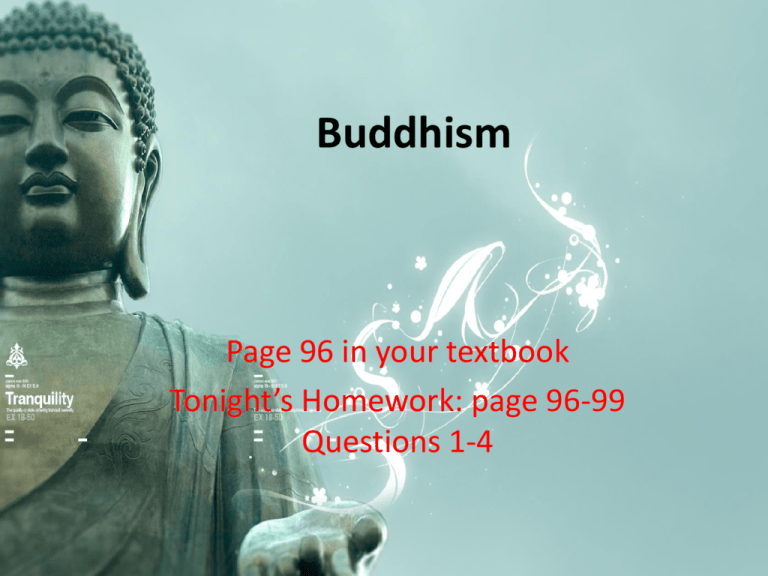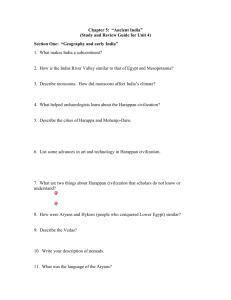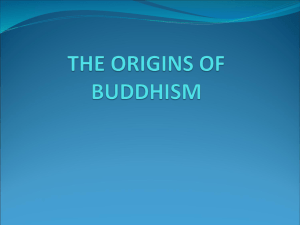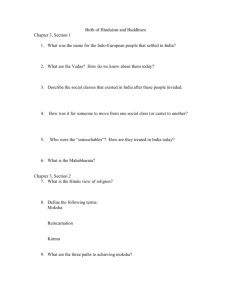Buddhism
advertisement

Buddhism Page 96 in your textbook Tonight’s Homework: page 96-99 Questions 1-4 Origins of Buddhism • In the 6th century BC, a new religion called Buddhism appeared in northern India and soon became the rival of Hinduism. • The founder of Buddhism was Siddhartha Gautama, known as the Buddha, or “Enlightened One”. Siddhartha’s Youth • Siddhartha came from a small kingdom in the foothills of the Himalaya (southern Nepal). • Born in 563 BC, he was the son of a high caste, ruling family. • Arranged marriage at age 16. • Legend says that after his birth, Siddhartha’s mother dreamed that a radiant white elephant descended to her from heaven, a sign that the boy would someday become a wandering holy man. • To prevent this, Gautama’s father kept him in his palace surrounded by comfort and luxury. The Search • One day as Siddhartha rode beyond palace gardens, he saw a sick person, an old person, and a dead body The Search • For the first time he became aware of human suffering. • Disturbed, he gave up his royal cloths, shaved his head, abandoned his family, and set off to find the true meaning of life. The Search • Gautama wandered for years, seeking answers from Hindu scholars and holy men. • He fasted and meditated • One day, he sat under a giant tree, determined to stay there until he understood the mystery of life For 48 days, evil spirits tried to tempt him to give up meditations Enlightenment • Then he suddenly believed he understood the cause and cure for suffering and sorrow • When he rose, he was Gautama no longer, but the “enlightened one” the Buddha Four Noble Truths • Buddha spent rest of his life teaching others his findings • In his first sermon since enlightenment, he explained the Four Noble Truths that are the heart of Buddhism. The Four Noble Truths 1. Life is full of suffering, pain, and sorrow 2. The cause of suffering is the desire for things that are illusions, such as riches, power, long life 3. The only cure for suffering is to overcome desire 4. The way to overcome desire is to follow the Eightfold path Growth of Buddhism • Siddhartha Gautama died around 483 BC at age 80 in what is today Nepal. • After his death, his followers traveled throughout India spreading his teachings. • Temples sprang up throughout the countryside. • During the next centuries, Buddhism and Hinduism began to compete for followers. Buddhist Philosophy • The Buddha denied the reality of the material world. • The pain, poverty, and suffering in the world is caused by attachment to material objects. • Once people let go of these attachments, pain and sorrow can be forgotten. • Achieving this wisdom leads one to the final goal, nirvana, or the union with the universe and release from the cycle of rebirth Theravada vs. Mahayana • • • • There are many different forms of Buddhism practiced all over the world. Theravada Buddhism is the more orthodox of the two and believers follow a specific path of enlightenment. In order to practice Theravada Buddhism in its pure form, a monastic life must be chosen. Children can join the monastic life from the age of seven. Southern (Sri Lanka, Thailand, Burma, Laos, Cambodia, parts of Southeast Asia) Theravada vs. Mahayana • Mahayana Buddhism is a collection of many different styles of Buddhism. • Although Meditation is practiced in many forms, Mahayana Buddhism is less traditional than its counter part. • Mahayana Buddhism contains many diverse rituals. • Northern (Tibet, China, Taiwan, Japan, Korea, Mongolia, parts of Southeast Asia ) Monastic Life A Buddhist monk is provided with shelter, food, clothing and medical cares. His life is secure, though not luxurious. His time is spent on the following activities: (1) study (2) the performance of assigned tasks for the maintenance of the monastery; (3) meditation (4) participation in collective observances like the recitation of the disciplinary code on new moon and full moon days; (5) and the performance of religious services for the community. Comparison with Hinduism • Siddhartha accepted the idea of reincarnation and karma. • However, he rejected the Hindu division of human beings in to castes based on previous reincarnations. • He taught that all human beings could reach nirvana as a result of their behavior in THIS life. • This made Buddhism appealing to the the lower castes. Comparing Buddhism with Hinduism Gods and worship: • Although Hindus worship many gods as manifestations of the supreme reality, Buddhism has no gods. • Siddhārtha also forbade worship of himself or his image. Comparing Buddhism with Hinduism • Position of women: In line with the social views of his time, Siddhārtha considered women inferior to men. Nonetheless, their position in Buddhist societies was generally better than elsewhere in India. Comparing Buddhism with Hinduism • Spread of Religion • Hinduism remained primarily in India • After the death of the Buddha, his followers spread his message throughout India and, eventually, to South East Asia and other parts of the world.








